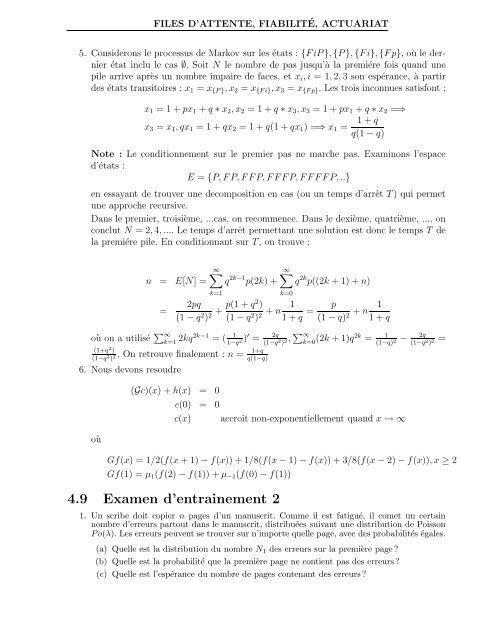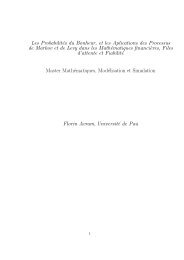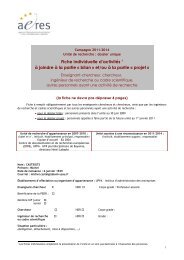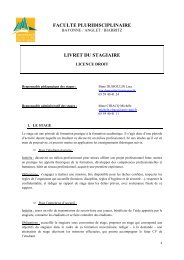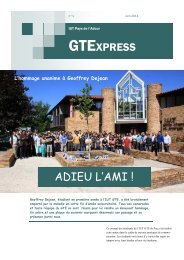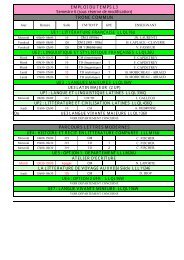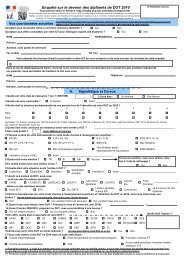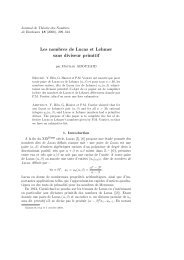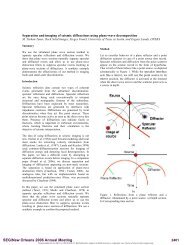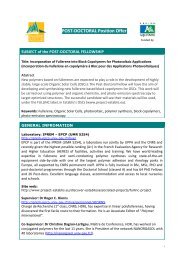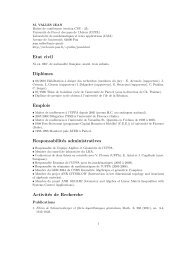Processus de Markov, de Levy, Files d'attente, Actuariat et Fiabilité ...
Processus de Markov, de Levy, Files d'attente, Actuariat et Fiabilité ...
Processus de Markov, de Levy, Files d'attente, Actuariat et Fiabilité ...
Create successful ePaper yourself
Turn your PDF publications into a flip-book with our unique Google optimized e-Paper software.
FILES D’ATTENTE, FIABILITÉ, ACTUARIAT<br />
5. Consi<strong>de</strong>rons le processus <strong>de</strong> <strong>Markov</strong> sur les états : {FiP }, {P }, {Fi}, {Fp}, où le <strong>de</strong>rnier<br />
état inclu le cas ∅. Soit N le nombre <strong>de</strong> pas jusqu’à la premiére fois quand une<br />
pile arrive après un nombre impaire <strong>de</strong> faces, <strong>et</strong> x i , i = 1, 2, 3 son espérance, à partir<br />
<strong>de</strong>s états transitoires : x 1 = x {P } , x 2 = x {Fi} , x 3 = x {Fp} . Les trois inconnues satisfont :<br />
x 1 = 1 + px 1 + q ∗ x 2 , x 2 = 1 + q ∗ x 3 , x 3 = 1 + px 1 + q ∗ x 2 =⇒<br />
x 3 = x 1 , qx 1 = 1 + qx 2 = 1 + q(1 + qx 1 ) =⇒ x 1 =<br />
1 + q<br />
q(1 − q)<br />
Note : Le conditionnement sur le premier pas ne marche pas. Examinons l’espace<br />
d’états :<br />
E = {P, FP, FFP, FFFP, FFFFP,..}<br />
en essayant <strong>de</strong> trouver une <strong>de</strong>composition en cas (ou un temps d’arrêt T) qui perm<strong>et</strong><br />
une approche recursive.<br />
Dans le premier, troisième, ...cas, on recommence. Dans le <strong>de</strong>xième, quatrième, ..., on<br />
conclut N = 2, 4, .... Le temps d’arrêt perm<strong>et</strong>tant une solution est donc le temps T <strong>de</strong><br />
la premiére pile. En conditionnant sur T, on trouve :<br />
n = E[N] =<br />
=<br />
∞∑<br />
q 2k−1 p(2k) +<br />
k=1<br />
où on a utilisé ∑ ∞<br />
k=1 2kq2k−1 = ( 1 ) ′ =<br />
1−q 2<br />
(1+q 2 )<br />
. On r<strong>et</strong>rouve finalement : n = 1+q<br />
(1−q 2 ) 2 q(1−q)<br />
6. Nous <strong>de</strong>vons resoudre<br />
où<br />
∞∑<br />
q 2k p((2k + 1) + n)<br />
k=0<br />
2pq<br />
(1 − q 2 ) 2 + p(1 + q2 )<br />
(1 − q 2 ) 2 + n 1<br />
1 + q = p<br />
(1 − q) 2 + n 1<br />
1 + q<br />
(Gc)(x) + h(x) = 0<br />
c(0) = 0<br />
c(x)<br />
2q , ∑ ∞<br />
(1−q 2 ) 2 k=0 (2k + 1)q2k = 1 −<br />
(1−q) 2<br />
accroit non-exponentiellement quand x → ∞<br />
2q<br />
(1−q 2 ) 2 =<br />
Gf(x) = 1/2(f(x + 1) − f(x)) + 1/8(f(x − 1) − f(x)) + 3/8(f(x − 2) − f(x)), x ≥ 2<br />
Gf(1) = µ 1 (f(2) − f(1)) + µ −1 (f(0) − f(1))<br />
4.9 Examen d’entrainement 2<br />
1. Un scribe doit copier n pages d’un manuscrit. Comme il est fatigué, il com<strong>et</strong> un certain<br />
nombre d’erreurs partout dans le manuscrit, distribuées suivant une distribution <strong>de</strong> Poisson<br />
Po(λ). Les erreurs peuvent se trouver sur n’importe quelle page, avec <strong>de</strong>s probabilités égales.<br />
(a) Quelle est la distribution du nombre N 1 <strong>de</strong>s erreurs sur la première page ?<br />
(b) Quelle est la probabilité que la première page ne contient pas <strong>de</strong>s erreurs?<br />
(c) Quelle est l’espérance du nombre <strong>de</strong> pages contenant <strong>de</strong>s erreurs?


